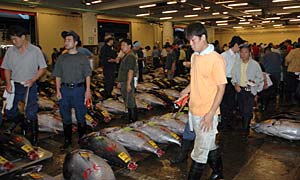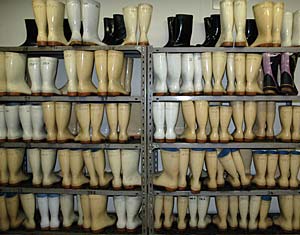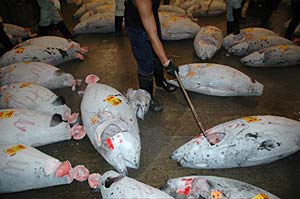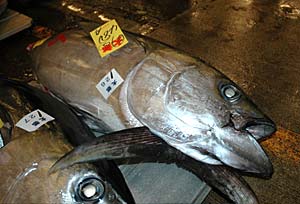Fish Stories
Air Date: Week of June 24, 2005

Fresh tuna (Photo: Kelly Jones)
The largest seafood market in the world, Tokyo’s Tsukiji, awakens early as fish are auctioned off to impatient buyers who inspect the soon-to-be sushi with flashlights and machetes. Reporter Kelly Jones has this audio postcard.
Transcript
[BACKGROUND NOISE OF A BUSY MARKET]

Fresh tuna auction. (Photo: Kelly Jones)
CURWOOD: Tourists are no longer welcome at the fresh and frozen tuna auctions at the Tokyo central wholesale market known as Tsukiji. It seems all those camera-toting curiosity seekers were getting in the way of business. Fortunately for us, Kelly Jones and her microphone did get the chance to record and send us this audio postcard.
JONES: More than six and a half million pounds of seafood from the world’s seven oceans arrive here at Tsukiji nightly. One kind in particular, bluefin tuna, darling of sashimi platters and, some say, endangered because of it. I trade in my shoes for a pair of cream colored galoshes and make it just in time for the opening bell of the fresh tuna auction.
[RINGING OF A BELL]
JONES: Picture an airplane hangar filled row upon row with fat titanium- and black-skinned fish so huge a hefty 10-year old could crawl inside. There are 350, maybe 400 of the submarine-shaped bluefin lying on individual wooden platforms on the cement floor. In just over an hour, all of them will sell.
[AUCTIONEER CHANTING]
JONES: An auctioneer on a footstool bobs and sways like a minister in a Pentecostal church. He moves ecstatically, all hand gestures and nods, his shoulders scrunching in time with his singsong chant.
|
JONES: All around him, potential buyers don poker faces and wield long-handled hooks. They crouch with flashlights, peer into sliced open bellies and prod cleaned-out cavities for the magic combination of scarlet flesh and abundant fat. CUSTOMER: How much are these tuna selling for? MERCHANT Expensive tuna cost 30,000 per kilo. And the average is 2,500. JONES: That’s 30,000 yen, or about 280 dollars a kilo for a typical whole fish so giant it takes two grown men with hooks a few swings and then one mighty heave to hoist the creature onto a flatbed wheelbarrow. [BACKGROUND SOUNDS OF AUCTION, THEN DIESEL ENGINE STARTING] JONES: Just a few steps away, men toss empty styrofoam boxes into a story-high heap and guys on tiny diesel trucks zigzag around them as another auction gets underway, this one for frozen tuna. [STYROFOAM SQUEAKING]
|








